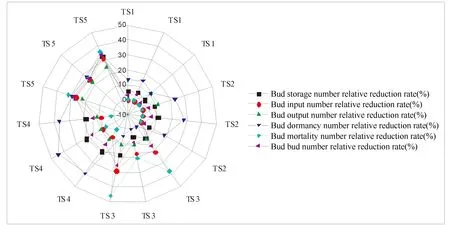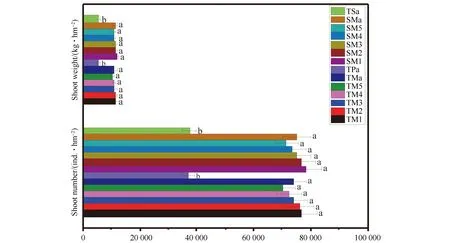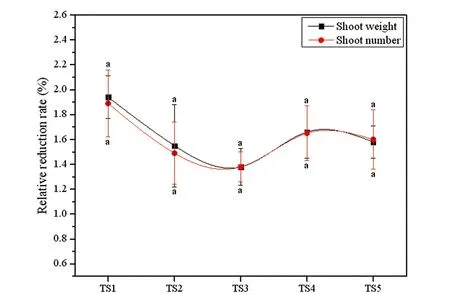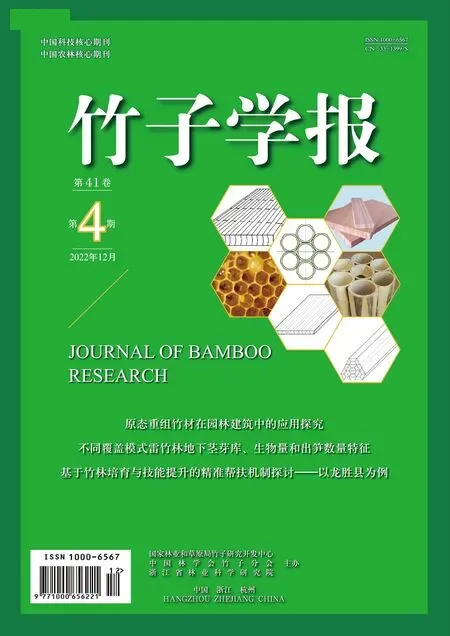Characteristics of Rhizome Bud Bank,Rhizome Biomass and Shoot Quantity under Different Mulching Modes of Phyllostachys praecox ‘Prevernalis’
GAO Gui-bin, WEN Xing, ZHANG Xiao-ping, ZHONG Hao, PAN Yan-hong, WU Zhi-zhuang*
(1.China National Bamboo Research Center, Hangzhou 310012, Zhejiang, China; 2.National Long-term Observation and Research Station for Forest Ecosystem in Hangzhou-Jiaxing-Huzhou Plain, Hangzhou 310012, Zhejiang, China; 3.Key Laboratory of Bamboo Forest Ecology and Resource Utilization of National Forestry and Grassland Administration, Hangzhou 310012, Zhejiang, China)
Abstract The objective of this study was to innovate the mulching cultivation mode of Phyllostachys praecox Z. D. Chu et C. S. Chao ‘Prevernalis’ plantation, effectively regulate the renewal of bamboo rhizome, and promote the sustainable management of bamboo forest. We compared the characteristics of rhizome bud bank, rhizome biomass, and quantity of sprouting shoots under traditional mulching (TM) and spaced mulching (SM) modes. The results showed that the total number of bud bank under SM was more than 470×104 individuals·hm-2, significantly higher than those under TM modes in 4-year (TM4) and 5-year (TM5) treatments (P<0.05). The relative reduction rate of bamboo bud banks of TM vs SM in TS1 (1-year TM vs 1-year SM) and TS2 (2-year TM vs 2-year SM) increased by 10%-20% in TS3 (3-year TM vs 3-year SM) and TS4 (4-year TM vs 4-year SM), and by 20%-40% in TS4 and TS5 (5-year TM vs 5-year SM). The overall rhizome biomass under SM was higher than that under TM. The rhizome biomass under TM decreased sharply after 3 years of TM (TM3) (P<0.05), whereas this change under SM was relatively slight. The relative reduction rate of bamboo rhizome biomass in TS1 and TS3 was less than 5%, and increased abruptly in TS4 and by more than 20% in TS5. The relative reduction rate of rhizome root biomass in TS5 was more than 15%. The shoot weight and shoot number under SM and TM decreased with increasing mulching period; the relative reduction rates of shoot weight and shoot number were less than 2% and not significantly different among treatments (P>0.05). The rhizome bud bank, rhizome biomass, and bamboo shoot productivity of bamboo stands under SM were higher than those under TM. Therefore, the spaced mulching mode not only maintained the rhizome bud bank and biomass of the bamboo forest, which is conducive to population renewal of the bamboo forest, but also maintained a certain level of bamboo shoot productivity.
Key words Phyllostachys praecox ‘Prevernalis’; Mulching mode; Bud bank; Biomass; Shoot quantity
Bamboo forest mulching, a kind of intensive management technology, offers great economic benefits, but also results in ecological consequences such as bamboo forest soil deterioration[1-2], bamboo forest decline, and others[3-4]. Nevertheless, driven by economic benefits, mulching continues to be widely used in bamboo forest cultivation. The most common methods used in bamboo production to solve the problems of soil degradation include the application of quicklime to control soil acidification and addition of foreign soil to reconcile the deteriorated soil[5]. Traditionally, bamboo population degradation has been prevented by temporarily suspending mulching and providing the bamboo forest self-renewal time[6]. These management measures differ in the amount of applied quicklime, the source of foreign soil, the rest-time of bamboo forest, and the provenance of newly planted bamboo[7-8]. Fertilizer type, the amount of fertilizer, and management protocols of the bamboo forest[9-10]to a large extent affect the soil properties and succession process of the bamboo forest[11-13], resulting in more complex changes in the growth and regeneration of the bamboo forest. These bring new challenges to the research of bamboo forest restoration technology and the relationship between mulched bamboo forest and environment.
The traditional bamboo forest mulching mode is already a mature technology, such as mulching material selection, surface temperature control, etc. Specifically, mulching for several years is alternated with several years of no mulching[14]. However, this approach may lead to unstable age structure of bamboo forest[15]. This is especially pronounced in cold years, when it is challenging to maintain new bamboo growth due to low temperatures, or at the time of high bamboo prices, when large quantities of bamboo shoots are harvested, disturbing the population balance. At the time of economic benefits from bamboo shoots, mulching time of bamboo forest may be prolonged, shortening the rest time, which will slow down the renewal of bamboo population and lead to premature decline of the forest[16].
To solve these problems, we developed a mulching cultivation program of bamboo forest (thereafter, referred to as spaced mulching) in which bamboo forest is divided into grids, and each grid is mulched alternately in a checkerboard pattern on a yearly basis. Bamboo shoots in mulched grids were removed, but left intact in un-mulched grids, to promote regeneration of the bamboo forest. The rhizome bud bank and biomass of bamboo forest are the important material basis for the regeneration of bamboo population and the output of bamboo shoots. At present, many studies have examined the bud bank, biomass, and output of bamboo shoots under the traditional mulching mode[17-19], but the variation in those parameters under different mulching modes remains unknown. The aim of this study was to investigate and compare the characteristics of rhizome bud bank, rhizome biomass, and shooting quantity of bamboo forest under the traditional mulching mode and the newly developed mulching mode. The results will provide reference for the efficient management of bamboo forest by innovating the mulching cultivation mode and promote the sustainable utilization of bamboo forest.
1 Materials and methods
1.1 Test site and materials
The test site is located in Lvjing village (119°82′E, 30°32′N), Jingshan Town, Yuhang District, Hangzhou City, Zhejiang Province, China. The climate type in the area is subtropical monsoon, with mild temperatures and abundant rainfall throughout the year. The annual average temperature is 16 ℃, the annual precipitation is 1 837 mm, the annual sunshine is 1 970 h, and the frost free period is 244 d. The soil is a fertile yellow and red loam with loose structure, which is very suitable for growth of bamboo plants. This area is dominated byPhyllostachyspraecoxZ. D. Chu et C. S. Chao ‘Prevernalis’, a small-diameter bamboo cultivar. Mulching, the main management practice in the area, is applied to promote growth of bamboo shoots in winter.
Under traditional mulching, bamboo productivity, population growth, and soil conditions inPh.praecox‘Prevernalis’ forests declined dramatically after 6 years of continuous mulching[20-21]. Therefore, we selected a bamboo forest with uniform site conditions and management level that had been traditionally mulched for 6 years. The bamboo forest was larger than 1 ha in the middle Tiao river alluvial plain with an altitude of less than 50 meters. The traditional mulching of the bamboo forest started on the 5th year after afforestation, and it was conducted in sequence of 3 years of mulching and 1 year of rest until the 6th year of cumulative mulching. Specifically, 10 cm of wheat bran were applied as the fermentation layer, and 15 cm of rice bran were mulched as the insulation layer. The density of bamboo stands was maintained at 14 000-16 000 individuals·hm-2, and only 1-4-year-old bamboos were kept. The diameter at breast height of the bamboo forest was mainly between 2.50 cm and 3.50 cm.
1.2 Test design
1.2.1 Traditional mulching mode Three 25 m×25 m quadrats (i.e., three replicates) were randomly set in the traditionally mulched bamboo forest. Initially, mulch was spread over entire quadrats on the second year of the experiment for two consecutive years (no mulching was applied on the first year), and thereafter it was repeated for 1 year every other year for a total of five mulching events. Investigated parameters of the bamboo forest were examined and recorded after each of the five cumulative mulching events and labeled as traditional mulching for 1 year (TM1), 2 years (TM2), 3 years (TM3), 4 years (TM4), and 5 years (TM5). The entire experimental period of mulching and rest periods was 10 years.
1.2.2 Spaced mulching mode Three 25 m×25 m quadrats (three replicates) were randomly set in the traditionally mulched bamboo forest. Each quadrat was evenly divided into 5 m×5 m grids (the grid size was selected so that the temperature of the fermentation layer was optimal for germination of bamboo shoots). Mulching was applied annually in a checkerboard pattern, and alternating between the grids every two years for a total of five mulching events per each quadrat (Fig. 1 a and b). Relevant parameters of the bamboo forest were recorded after each of the five consecutive mulching events and labeled: spaced mulching for 1 year (SM1), 2 years (SM2), 3 years (SM3), 4 years (SM4), and 5 years (SM5). With this mulching method, the bamboo forest did not need to rest, which shortened the whole experimental period to 5 years and reduced by half the total annual mulching area.

Fig.1 Spaced mulching modeNote: Mulching, No-mulching. a: the first year; b: the next year, alternating between the grids every 2 years.
1.3 Investigated bamboo forest parameters
1.3.1 Bud bank measurements After each mulching event, from October to November of the same year, three 1 m2small quadrats (three replicates) were randomly set on each 25 m×25 m mulched ground; a total of nine 1 m3small quadrats (nine replicates) were set on three 25 m×25 m quadrats. Bamboo rhizomes were collected from each quadrat, washed, and dried. Number of dormant buds, dead buds, and germination buds was recorded, and the composition of bud bank was analyzed as described by Gaoetal.[16]. The bud storage number was defined as the sum of dormant buds of 1-year old and ≥2-year-old rhizomes; bud input number was defined as the number of dormant buds of 1-year old rhizomes; bud output number was defined as the number of germinating buds on ≥2-year-old rhizomes; bud dormant number was defined as the number of dormant buds on ≥2-year-old rhizomes; bud mortality number was defined as the number of dead buds on 1-year old, and ≥2-year-old rhizomes; total bud number was defined as the sum total of the number of lateral buds of 1-year old and ≥2-year-old rhizomes.
1.3.2 Rhizome biomass measurements After the bud bank data were recorded, the excavated bamboo rhizomes and roots of each small quadrat were pruned and separated with pruning shears, and their fresh weight was measured. The rhizomes and roots were then placed in an oven at 105 ℃ for 30 min, and then dried at 70 ℃ to constant weight to determine dry weight and their biomass.
1.3.3 Evaluation of shooting quantity After 20 days of mulching, bamboo shoots started emerging. The shoots were dug daily, counted, and weighed.
The annual average output of bamboo shoots of the total quadrat under spaced mulching (TSa) was calculated as half the annual output of bamboo shoots, because the actual mulched area of the bamboo forest was half that of each quadrat.
The annual average output of bamboo shoots of the total period under traditional mulching (TPa) was calculated as follows: TPa = the total output of bamboo shoots/10, because the whole experimental period of traditional mulching was 10 years.
1.4 Data analysis
Origin 9.0 (OriginLab, Northampton, MA, USA) was used to plot the data; single factor random block analysis of variance andStudent-Newman-Keuls(SNK) test (i.e., Q test) were conducted for multiple comparison of the means in SPSS 19.0 (IBM, Armonk, NY, USA). The relative reduction rate (%) of TM vs SM to: The relative reduction rate (%) of bud number, rhizome biomass, and shoot quantity under TM vs. SM was calculated as follows: TS1 (TM1 vs SM1) = (SM1-TM1)/TM1×100; TS2 (TM2 vs SM2) = (SM2-TM2)/TM2×100; TS3 (TM3 vs SM3) = (SM3-TM3)/TM3×100; TS4 (TM4 vs SM4) = (SM4-TM4)/TM4×100; TS5 (TM5 vs SM5) = (SM5-TM5)/TM5×100.
2 Results
2.1 Quantitative characteristics of bud bank in bamboo forest under different mulching modes
As shown in Tab. 1, the bud storage number was significantly higher in SM1 (P<0.05), reaching 407×104individuals (ind.)·hm-2, than in other treatments. The bud storage number under SM was greater than 300×104ind.·hm-2, and significantly higher than that of TM4 and TM5 (P<0.05). There was no significant difference in bud input number among SM treatments (P>0.05), but this number was significantly higher compared with that of TM3—TM5 treatments (P<0.05). There was no significant difference in bud output number among SM treatments (P>0.05), but it was significantly higher than that of TM2—TM5 treatments (P<0.05). The number of dormant buds was significantly higher in SM1 (200×104ind.·hm-2) than in other SM and TM treatments (P<0.05). The number of dormant buds in SM was greater than 120×104ind.·hm-2, significantly higher than that of TM4 and TM5 (P<0.05). The number of dead buds in SM was high, which was associated with the large number of buds. The total number of buds in SM treatment was greater than 470×104ind.·hm-2, significantly higher than that in TM4 and TM5 (P<0.05). These results showed that the decline in bud number under SM was slower than that under TM, and the difference in bud bank parameters between the two mulching methods increased with mulching time.

Tab.1 Bud bank characteristics of bamboo forests under different mulching treatments
The change in TS1 and TS2 was relatively small for all bud bank indexes, except for the relatively large relative reduction rate of dormant buds (Fig. 2), which showed no significant decreases in bud bank parameters of traditionally mulched bamboo forest in this stage when compared with the forest subjected to SM. TS3 and TS4 of each bud bank index increased sharply (Fig. 2): TS3 of dead buds ranged from 20% to 50%, TS4 of dormant buds was about 40%, and TS3 and TS4 of the remaining bud indexes remained between 10% and 20%. The change in TS5 was gentle for each index and maintained at 20% to 40% (Fig. 2). These results indicated that the capacity of SM to maintain bud bunk indexes improved with increasing mulching time when compared with that of TM.

Fig.2 Relative reduction ratios of bud bank indexes of bamboo forests between traditional mulching and spaced mulchingNote: TS1, TM1 vs SM1; TS2, TM2 vs SM2; TS3, TM3 vs SM3; TS4, TM4 vs SM4; TS5, TM5 vs SM5. Treatment abbreviations are defined in Tab. 1.
2.2 Quantitative characteristics of rhizome biomass in bamboo forests under different mulching modes
One by one comparison, the rhizome biomass in SM treatments was greater than that in TM (Fig. 3). Under TM, the biomass of rhizome and that of root decreased sharply and significantly (P<0.05) after TM4, while that in plots under SM decreased gradually, reaching significant values at SM5 (P<0.05). These results showed that the rhizome biomass decline in bamboo forest under SM was slower than that under TM, and the difference between the two methods increased and become significant with mulching time.

Fig.3 Rhizome biomass characteristics of bamboo forests under different mulching treatmentsNote: Vertical bars are standard deviations. Lowercase letters indicate significant difference at P<0.05. Treatment abbreviations are defined in Tab. 1.
TS1, TS2, and TS3 of rhizome biomass and rhizome root biomass were low, less than 5%, and the difference among the treatments was not significant (P>0.05; Fig. 4). This indicated that TM and SM were similar in their capacity to preserve rhizome biomass in the first few years of mulching. However, TS4 and TS5 of rhizome and rhizome root biomass increased sharply (Fig. 4): TS4 and TS5 of rhizome biomass increased from less than 5% to more than 15% and more than 20%, respectively, whereas TS4 and TS5 of rhizome root biomass increased from less than 5% to more than 10% and more than 15%, respectively, and the difference between TS4 and TS5 was significant (P<0.05). These results showed that the ability of SM to maintain rhizome biomass of bamboo forest became more notable with the increase in mulching time.

Fig.4 Relative reduction ratio in rhizome biomass of bamboo forests between traditional mulching bamboo forests and spaced mulching bamboo forestsNote: Vertical bars are standard deviations. Lowercase letters indicate significant difference at P<0.05. TS1 TS5 are defined in Fig. 2.
2.3 Quantitative shoot characteristics of bamboo forests under different mulching modes
As shown in Fig. 5, the number of shoots and their weight under SM and TM treatments decreased with increasing mulching time, but the decrease was not significant (P>0.05). Because of different spatial and temporal distribution of mulching under SM and TM, the shoot number and shoot weight in each bamboo forest were significantly different from the annual averages of SM total sample plot and TM total period (P<0.05); the difference between the latter two was not significant (P>0.05). Therefore, there was no significant spatial and temporal change in bamboo shoot productivity under the two mulching modes.

Fig.5 Shoot yield characteristics of bamboo forests under different mulching protocolsNote: TSa, total sample plot annual average under spaced mulching; SMa, spaced mulching annual average; TPa, total period annual average under traditional mulching; TMa, traditional mulching annual average. Vertical bars are standard deviations. Lowercase letters indicate significant difference at P<0.05. Treatment abbreviations are defined in Tab. 1.
The relative reduction rates of bamboo shoot weight and shoot number were very low and not significant (P>0.05; Fig. 6), both less than 2%, and TS2—TS5 decreased to about 1.5% with the increase in mulching time, indicating that, despite the higher bamboo shoot productivity under SM than under TM, long-term mulching was not all conducive to the maintenance of shoot productivity of bamboo forest.

Fig.6 Relative reduction ratio in shoot yield of bamboo forests between traditional mulching and spaced mulchingNote: Vertical bars are standard deviations. Lowercase letters indicate no significant difference at P<0.05. TS1—TS5 are defined in Fig. 2.
3 Discussion
Clonal plants develop unique adaptation strategies to various complex environmental conditions to maintain their own survival, growth, and reproduction[22-24], such as resource allocation strategy, specialization of labor division, physiological integration, nutrition storage and sharing, survival risk sharing, and others. Bamboo, as an evergreen, perennial plant that mainly propagates asexually, inevitably shows a common response to environmental changes similar to other clonal plants[25]. Based on the uniqueness of bamboo growth, after many experimental trials, we developed the spaced mulching cultivation method that is compatible with bamboo′s unique growth. By changing the traditional vertical alternate mulching mode along the time axis into the horizontal spaced mulching mode along the spatial axis, we aimed to effectively promote the regeneration of bamboo forest by preserving the number of newly developed bamboo shoots and growth of new rhizomes every year.
Studies showed that, under extreme habitat or strong disturbance conditions, plants often use the bud bank as a nutritional reproduction mode of potential population to complete vegetation regeneration[26-28]. Changes in environmental factors such as water and nutrient content in a habitat would affect the bud bank, altering their structure and quantity[29]. In the present study, it was found that the mulching of bamboo forest, as a way of human interference, had a profound impact on the composition of rhizome bud bank in the bamboo forest. The content of bud bank in spaced mulching was higher than that in traditional mulching, and the difference between the two become more significant as mulching time expanded. Meanwhile, the overall rhizome biomass of the bamboo forest under spaced mulching was higher than that of the traditionally mulched forest. With the increase in mulching time, the ability of the spaced mulching mode to preserve rhizome biomass of the bamboo forest become more obvious, indicating that, through the process of spaced mulching, the strong asexual colonization ability of bamboo via rhizome not only rapidly augmented the renewal of the rhizome in un-mulched grids, but also contributed to rhizome renewal in mulched grids, increasing the rhizome biomass of the mulched grid, supplementing the bud bank, and promoting the overall renewal of bamboo forest.
According to Gaoetal.[16], the long-term traditional mulching of bamboo forest decreases the bud storage rate, increases the bud output rate, and decreases the bud input capacity-“expenditure” is greater than “income” in bud bank. Therefore, in order to promote sustainable management of bamboo forest, it is necessary to increase the input of buds and reduce the output of buds for restoration of a declining bamboo forest population. In the present study, we found that (1) the longer the mulching time, the slower the bud bank decreased under the spaced mulching; and (2) although the bamboo shoot productivity under the spaced mulching was higher than that under traditional mulching, the difference was not significant. These results showed that the spaced mulching mode could maintain the bud bank of bamboo forest, without increasing its expenditure, and that this method could sustain certain level of bamboo shoot productivity. Nutritional integration between the mulched grid and un-mulched grid is possible. At the time of bamboo harvest from mulched grids, the bamboo in un-mulched grids may be exposed to unfavorable growth conditions caused by excessive output of harvested bamboo shoot resources through nutrition integration. The pathway and process of nutritional integration warrants further study. The number of bamboo shoots under the two mulching modes decreased with increasing mulching time, indicating that, regardless of the method, long-term mulching was not conducive to bamboo shoot output likely due to soil degradation caused by long-term mulching of bamboo forests[30-31]. Therefore, to realize the sustainable management of bamboo forest, the next step should focus on the development of bamboo forest soil ecological restoration technology.
4 Conclusion
The content of bud bank and rhizome biomass in the bamboo forest under spaced mulching were higher than those in the traditionally mulched bamboo forest, and the difference further increased with mulching time. Thus, the spaced mulching of bamboo forest could maintain the bud bank and rhizome biomass, as well as promote effective regeneration of declining bamboo forest populations. The bamboo shoot productivity under the spaced mulching was higher than that under the traditional mulching, and the spaced mulching could maintain a certain bamboo shoot productivity. However, long-term mulching using the two methods was not conducive to bamboo shoot bud output, and the recovery technology of bamboo forest was still the bottleneck of the decline of mulching bamboo forest.

